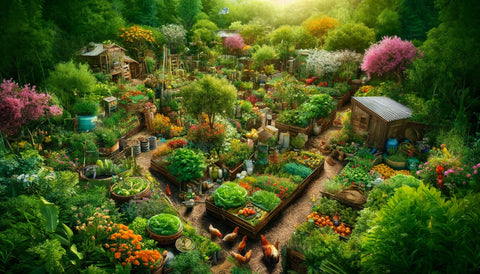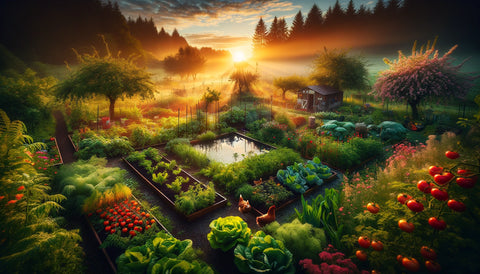The Sustainable Benefits of Permaculture Gardening
Sustainable Living with Permaculture Gardens: A Comprehensive Guide
Permaculture
How Permaculture Gardens Promote Sustainability
Sustainable living is possible with permaculture gardening. Environmentalists like permaculture because it encourages sustainability. Explore permaculture gardens' sustainable living function.
Permaculture gardening meaning
Eco-friendly permaculture farming produces food. This comprehensive approach replicates nature to create waste- and labor-saving systems. This landscape design emphasises sustainability.
Permaculture Gardens' Value
Permaculture gardens are essential to sustainability. They promote sustainable ecosystems that preserve the world and humans. We live with nature and maintain it using permaculture.
Sustainable Resource Use
Water, sunlight, and soil are used efficiently in permaculture gardening. Permaculture conserves resources using new ways including rainwater collection, composting, and solar orientation. Thus, it actively protects Earth.
Safeguarding biodiversity
A healthy ecosystem requires biodiversity, which permaculture fosters. The garden design creates a dynamic, favorable ecosystem for plants, insects, and animals.
Healthy Food Production
Permaculture gardens produce nutrient-rich fruits, vegetables, and herbs, reducing pesticide and synthetic fertilizer usage in industrial agriculture. Organic food production in permaculture increases food security and health.
Community Building
Permaculture promotes surplus sharing. Community and collaborative environmental and social solutions for food, seeds, skills, and time are supported.
One last thought
Sustainable life includes permaculture gardens' principles of land, people, and fair sharing. Permaculture fosters sustainability, community, and world improvement.
Construction of a Permaculture Garden: Tips
Permaculture gardens foster biodiversity, reduce carbon emissions, recycle organic waste, and generate organic food. Below are permaculture garden building instructions.
First, watch and plan
Check your yard or garden areas. Take into account sunlight, shade, vegetation, slope, and drainage. Start a garden after studying what works in your area. Use simple sketches or complicated permaculture software.
Second: Pick Plants
Think native and edible. Indigenous plants are more adaptive and sustain biodiversity. Your household may acquire fresh veggies from edible plants. Improve ecosystem using complimentary plants. A well-planned garden may be self-sufficient.
Tips: Planting Friends
Permaculture uses companion planting. This approach involves arranging plants to shade each other or repel pests.
3. Create Healthy Soil
A permaculture garden needs healthy soil. Earthworms, mycorrhizal fungus, compost, and organic mulch boost soil fertility. Avoid environmentally harmful synthetic fertilizers and pesticides.
Water Efficiency, Step 4
Finally, assess water utilization. Permaculture prioritizes water efficiency. Swales, drip irrigation, and rainwater harvesting may deflect rain. Water efficiently—every drop counts.
Tip: Mulching
Mulching improves soil quality and absorbs water, minimizing garden irrigation.
Your permaculture garden may be built easily. Planning your design, choosing the right plants, improving the soil, and employing efficient irrigation systems will create a sustainable, productive, and eco-friendly green space.
All gardens have their unique permaculture style. Create a permaculture garden by trying, learning, and following nature.
Climate Change Permaculture Gardening
Our sensitive biosphere is under pressure from climate change, making sustainable living crucial for everyone. The agricultural design of permaculture can fight climate change.
Knowledge about Permaculture
'Permanent agriculture,' or permaculture, emphasizes natural cooperation. Like natural ecosystems, this unique method promotes variety, sustainability, and resilience. A sustainable system that balances the environment and human needs is the objective.
Composting, crop rotation, water conservation, and native planting are permaculture practices. These strategies reduce non-renewable resource usage and strengthen climate resilience.
Carbon Sequestration, Permaculture
Carbon sequestration is a key permaculture advantage. Traditional agriculture releases carbon into the atmosphere, whereas permaculture systems keep it in soil and plants. Preventing climate change requires this large greenhouse gas output reduction. 
Permaculture gardening
Permaculture gardening is easy. Start with kitchen trash composting and rainwater collection. You may employ sophisticated methods while learning the basics. Remember, every little amount helps battle climate change.
Joint Global Movement
Permaculture is a global gardening and sustainable living movement. Joining permaculturists is a strong statement against climate change and a step toward a greener, more diverse, and resilient world.
To conclude, climate change's huge threats need immediate action. Practical sustainability measures in permaculture gardening combat climate change. Let's use nature, encourage biodiversity, and improve the planet one garden at a time.
Permaculture Enables Sustainability
Nowadays, sustainability is more than a buzzword. As climate change and environmental protection become more obvious, more people want to contribute. Permaculture combines land use with sustainability. How permaculture may be sustainable is discussed here.
What's Permaculture?
Permaculture leverages nature for design. This sustainable land use technique creates self-sustaining ecosystems through ecology. Permaculture may be employed in home gardens, small farms, and large farms by respecting nature and being innovative.
Permaculture sustainability
Permaculture may alter our lifestyle, home, and society. Here are some ways permaculture promotes sustainability.
Design that conserves energy
Permaculture conserves energy. Planning and design may reduce energy use. Think about your home or garden plan. Can it maximize natural light to minimize midday artificial light? Do solar and wind turbines generate power? Permaculture saves plenty of energy.
Organic farming, gardening
Natural farming is permaculture's purpose. Organic fertilizers and pesticides boost soil biodiversity. Local foods and flora benefit native wildlife and the environment.
Manage and Reduce Waste Permaculture considers "waste" a resource. Composting organic waste reduces landfill rubbish and enriches soil. Permaculture includes recycling and circular economy.
Permaculture practices conserve water by catching rainfall and creating outdoor places for storage and collection.
Permaculture gives ethical, practical directions for responsible living in addition to techniques and solutions. Emulating natural ecosystems and limiting non-renewable resource use increases sustainability. Permaculture helps you live sustainably and benefit others.






Leave a comment